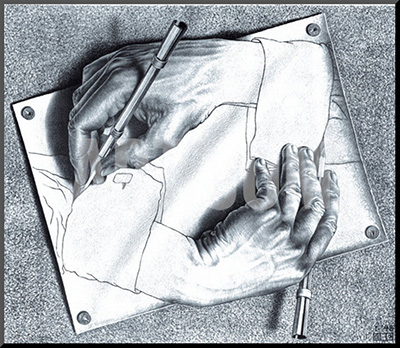|
Drawing with Your Non-Dominant Arm

Permission is granted to reprint the following article as long
as no changes are made and the byline, copyright information,
and the resource box is included. Please let me know if you
use this article by sending an email to dje@newedisongazette.com.
Drawing with Your Non-Dominant Arm
Copyright © February 19, 2017 Douglas W Jerving.
All Rights Reserved.
First off: I never saw this in any art book, tutorial, or video. I just decided on my own to
try developing my opposite hand/arm to more fully understand how my dominant hand/arm works.
This was, and is, a science experiment, as far as science and art may conjugate.
Artists understand that eye-muscle coordination is a large part of their skill. Discipline
the hand to respond to the eye and vice-versa. This is known in the art community as
muscle-memory. Musicians use the same technique; for instance, hand drumming requires teaching
the muscles in the hands to respond in certain coordinated patterns of rhythm. Practice makes
the eye and the hand correspond. This is exactly how children learn hand-eye coordination. It
is how they learn to draw and how to write their letters. By default, children favor the
dominant hand to the exclusion of the non-dominant, unless they are encouraged (or forced) to
favor the other hand.
A minority of children become ambidextrous, favoring both hands. A friend of mine was ambi.
He was able to write forwards, backwards, and both at the same time with both hands simultaneously.
It did not matter what you asked him to write: it was not practiced; he could do it fluently. I
have always been dumbfounded about his ability.
As an artist, I have always been left-handed (now going on 60 years). I have drawn and painted with
my left hand all my life. It was fortuitous for me when I had my hand accident in 1989 that my right
hand was damaged. My dominant hand was not affected. My ability to write (though not to type) or to
draw was not affected.
I have very limited use in my non-dominant right hand. Of course, this discouraged my use of the
right hand even more than it would have for most other people. My left-handedness since that time
has been far more pronounced. Still, my right hand, despite the handicap, is useful for most daily
tasks.
This brings me back to my original point. Can the non-dominant hand be trained (hand-eye coordination)
for writing, or in my case, for drawing to the same extent as the dominant? This is exactly what my
experiments with my right-hand drawing were intended to prove. If I train my opposite to react as the
dominant, will I be able to draw similarly both left and right handed?
I was certain that I could perfect both hands to the same degree. It was just a matter of training.
Hand-eye coordination. It was the same as a child learning how to write the alphabet. Ambidexterity
is related to favored training more than to inborn abilities. As soon as we shove off the mental
predispositions favoring handedness, we become capable of both-handedness!
Obviously, this opens the possibility of multi-tasking virtually everything else beyond just hand-eye
coordination, whether we are speaking of art and hand-writing, or politics, ethics, religion, or what
have you. But that can of worms can be saved for another day.
For a mere two weeks, I have been practicing drawing with my right (non-dom) hand. My arm gets sore
because muscles are being used in ways they never were used before the experiment. But my hand/arm/eye
coordination gets better as I go. More and more I find that my right arm drawing is as good (well,
nearly) as my dominant left.
I will keep playing with this technique. I think it could be a useful training exercise for all artists.
If nothing else, it teaches you to think about art from a new perspective. Right and left brain, right
and left hand, to work on the same level. It is all just muscle-memory.
The art shown below is crude. It was created entirely using my non-dom hand. Just remember, as you view
it, that it was the result of a mere two weeks of playing and training. Remember how long it took you
(or your children) to train themselves to copy the alphabet or draw a cat.
It's like learning how to ride a bike. If you've already got the basics, it does not take long to learn
the next step. Learning your opposite hand is the next step from what you are already good at.
Muscle-memory (teaching your hand to respond to what your brain already knows) is all you need.
The common denominator is practice.
------------------------
Doug Jerving is the publisher of the NewEdisonGazette.com. You may contact him at
dje@newedisongazette.com.
=================================

Return to The New Edison Gazette main site.
|
|